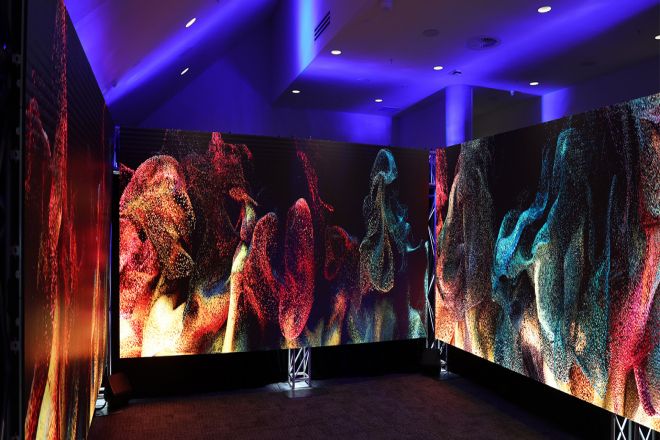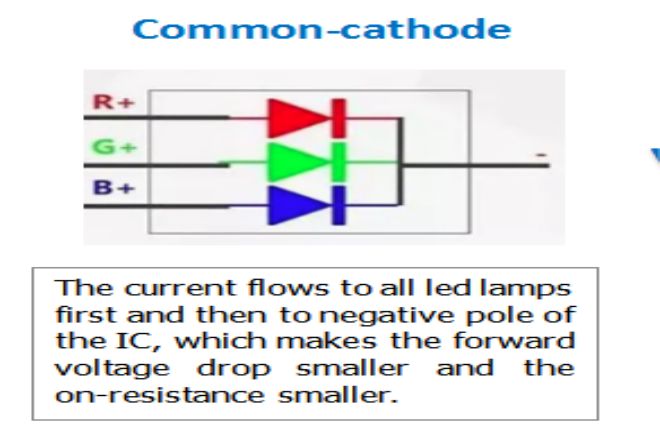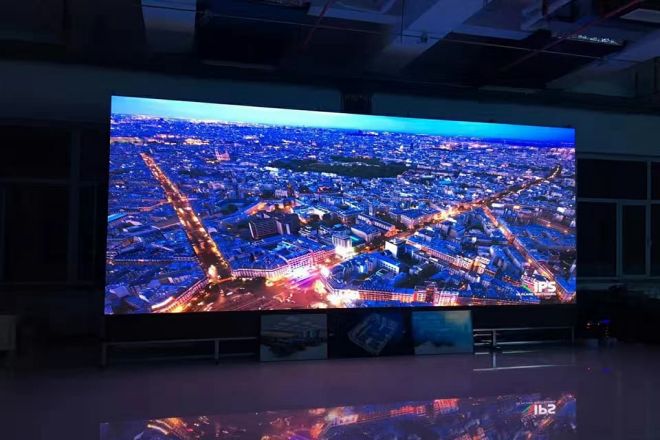مقدمة

ومع التطور السريع للعلوم والتكنولوجيا، عرض الصمام أصبحت التكنولوجيا، كوسيلة مهمة لنشر المعلومات الحديثة، موجودة في كل مكان في حياتنا.
من شوارع المدينة الصاخبة إلى شاشات العرض في قاعات المؤتمرات الداخلية، أصبحت شاشات LED جزءًا لا غنى عنه في الإعلان والإعلام والثقافة والترفيه بمزاياها المتمثلة في السطوع العالي والتباين العالي وزاوية الرؤية الواسعة.
من بين العديد من التفاصيل الفنية لشاشات العرض LED، تعد تقنية الكاثود المشترك، باعتبارها واحدة من التقنيات الرئيسية، ذات أهمية كبيرة لتحسين تأثير العرض لشاشة العرض وتقليل استهلاك الطاقة.
1. تحليل مفصل لتكنولوجيا الكاثود المشترك

تقنية الكاثود المشترك هي طريقة قيادة لشاشات العرض LED، حيث يتم توصيل الكاثود (القطب السالب) لخرز مصباح LED معًا، بينما يتم التحكم في الأنود (القطب الموجب) بشكل مستقل بواسطة دوائر قيادة مختلفة. يسمح هذا الهيكل بالتحكم المستقل في الجهد والتيار للألوان الثلاثة لخرز مصباح LED الأحمر والأخضر والأزرق (RGB)، وبالتالي تحقيق سطوع أكثر دقة وضبط اللون.
1) مزايا بنية الكاثود المشترك:
استهلاك منخفض للطاقة: نظرًا لأنه يمكن تشغيل تقنية الكاثود المشترك بشكل مستقل وفقًا للاحتياجات الفعلية لخرزات مصباح RGB، يمكن تجنب استهلاك الطاقة غير الضروري، ويمكن تقليل استهلاك الطاقة الإجمالي.
سطوع موحد: من خلال التحكم بشكل مستقل في كل حبة LED، يمكن ضمان سطوع شاشة العرض ليكون أكثر توحيدًا، وتجنب الإفراط في السطوع أو الإفراط في الظلام المحلي.
تعبير قوي عن اللون: من خلال التحكم الدقيق في الجهد والتيار، يمكن لتقنية الكاثود المشترك تحقيق مستويات ألوان أكثر ثراءً وإعادة إنتاج ألوان أكثر دقة.
2) حدود بنية الكاثود المشترك:
تعقيد عالي: نظرًا لأن كل حبة LED تحتاج إلى التحكم بشكل مستقل، فإن تصميم الدائرة معقد نسبيًا، مما يزيد من صعوبة وتكلفة التصنيع.
متطلبات عالية لشرائح التشغيل: من أجل تحقيق التحكم الدقيق في الجهد والتيار، يجب اختيار شرائح تشغيل عالية الأداء، مما يزيد أيضًا من التكلفة.
3) طريقة تنفيذ تقنية الكاثود المشترك
3.1). تصميم الأجهزة:
تصميم الدائرة: وفقًا لمواصفات ومتطلبات شاشة عرض LED، قم بتصميم هيكل دائرة مناسب لضمان إمكانية توصيل كاثود كل حبة LED معًا بينما يمكن التحكم في الأنود بشكل منفصل.
اختيار شريحة التشغيل: حدد شريحة تشغيل عالية الأداء لتحقيق التحكم المستقل في حبات مصباح RGB وتنظيم الجهد والتيار بدقة.
3.2) تصميم البرمجيات:
استراتيجية القيادة: صياغة استراتيجية قيادة مناسبة لضمان أن شاشة العرض LED يمكن أن تعمل بثبات وموثوقية.
خوارزمية تعديل السطوع: وفقًا لسيناريو التطبيق الفعلي، قم بتصميم خوارزمية تعديل السطوع المناسبة لتلبية متطلبات السطوع المختلفة.
2. تطبيق تقنية الكاثود المشترك في أنواع مختلفة من شاشات العرض LED
بفضل المتطلبات العالية للسطوع واللون في البيئات الداخلية، يمكن لتقنية الكاثود المشترك تحقيق مستويات ألوان أكثر ثراءً وإعادة إنتاج ألوان أكثر دقة من خلال التحكم الدقيق في الجهد والتيار، وبالتالي تلبية متطلبات العرض عالية الجودة لشاشات العرض LED الداخلية.
تحتاج شاشات العرض LED الخارجية إلى تحمل تأثير البيئات القاسية المختلفة، مثل درجات الحرارة العالية ودرجات الحرارة المنخفضة والرطوبة وما إلى ذلك. يمكن لتقنية الكاثود المشترك تحسين استقرار وموثوقية شاشة العرض عن طريق تقليل استهلاك الطاقة وتقليل توليد الحرارة، وبالتالي ضمان أن شاشة العرض LED الخارجية يمكن أن تعمل بثبات لفترة طويلة.
تتميز شاشة العرض LED المرنة بخصائص الانحناء والطي، والتي يمكنها التكيف مع بيئات التثبيت المعقدة المختلفة. يمكن لتقنية الكاثود المشتركة ضمان أن شاشة العرض LED المرنة لا تزال قادرة على الحفاظ على تأثير عرض مستقر في حالة الانحناء أو الطي من خلال التحكم الدقيق في الجهد والتيار.
3. تحليل الأداء وتحسين تقنية الكاثود المشترك

1) تقييم معايير الأداء
- توحيد السطوع:
يعد توحيد السطوع أحد المؤشرات المهمة لتقييم تأثير العرض لشاشات العرض LED. يمكن لتقنية الكاثود المشترك تحقيق ضبط دقيق للسطوع لكل بكسل من خلال التحكم المستقل في خرزات مصباح RGB، وبالتالي تحسين توحيد سطوع شاشة العرض.
في التطبيقات العملية، يمكن قياس سطوع الشاشة باستخدام أداة اختبار التوحيد، ويمكن إجراء المعايرة والتحسين بناءً على نتائج الاختبار.
- كفاءة الطاقة:
يمكن لتقنية الكاثود المشترك تقليل استهلاك الطاقة لشاشات LED من خلال التحكم الدقيق في الجهد والتيار. لا يساعد تحسين كفاءة الطاقة في تقليل استهلاك الطاقة فحسب، بل يقلل أيضًا من تكلفة تشغيل الشاشة.
عند تقييم كفاءة الطاقة، يمكن قياس استهلاك الطاقة للشاشة عند سطوع مختلف، ويمكن حساب نسبة كفاءة الطاقة الخاصة بها.
- مصداقية:
تنعكس موثوقية تقنية الكاثود المشترك بشكل أساسي في استقرار وعمر الشاشة. يمكن تحسين موثوقية الشاشة من خلال تحسين دائرة القيادة وتحسين خوارزمية ضبط السطوع وتعزيز نظام تبديد الحرارة. في التطبيقات العملية، يمكن استخدام طرق مثل اختبارات التشغيل طويلة المدى واختبارات دورة درجة الحرارة لتقييم موثوقية الشاشة.
2) تدابير التحسين
- التصميم الأمثل لدائرة القيادة:
دائرة القيادة هي الجزء الأساسي لتقنية الكاثود المشترك، ويؤثر تصميمها بشكل مباشر على أداء الشاشة. يمكن تحقيق تحسين دائرة القيادة باستخدام شرائح قيادة عالية الأداء، مما يقلل من المعاوقة والضوضاء في الدائرة، ويحسن قدرة الدائرة على مقاومة التداخل.
يمكن أن تؤدي إجراءات التحسين هذه إلى تحسين كفاءة واستقرار دائرة القيادة، وبالتالي تحسين أداء العرض.
- تحسين خوارزمية تعديل السطوع:
تُعد خوارزمية ضبط السطوع عاملاً رئيسيًا يؤثر على سطوع الشاشة وأدائها اللوني. ومن خلال تحسين خوارزمية ضبط السطوع، يمكن تحقيق تحكم أكثر دقة في السطوع ومستويات ألوان أكثر ثراءً.
على سبيل المثال، يمكن استخدام خوارزمية ضبط السطوع التكيفي لضبط سطوع الشاشة تلقائيًا وفقًا للتغيرات في الإضاءة المحيطة، أو يمكن استخدام خوارزمية إدارة الألوان لمعايرة لون الشاشة وتحسينه.
- تعزيز نظام تبديد الحرارة:
يعد نظام تبديد الحرارة أمرًا بالغ الأهمية لضمان التشغيل المستقر لشاشة LED. يمكن تحسين نظام تبديد الحرارة باستخدام مواد تبديد الحرارة الفعالة، وتحسين هيكل تبديد الحرارة، وإضافة مراوح تبديد الحرارة.
يمكن أن تؤدي تدابير التحسين هذه إلى تقليل درجة حرارة تشغيل الشاشة وتحسين موثوقيتها وعمرها الافتراضي. وفي الوقت نفسه، يمكنها أيضًا تقليل المشكلات مثل ضعف السطوع وتشوه اللون الناجم عن درجات الحرارة المرتفعة.
4. تطبيق السوق واتجاه تطوير تكنولوجيا الكاثود المشترك
1) حالة تطبيق السوق
- وسائل الإعلان:
تُستخدم تقنية الكاثود المشترك على نطاق واسع في مجال الوسائط الإعلانية نظرًا لسطوعها العالي وأدائها اللوني الممتاز. في مراكز التسوق والمجمعات التجارية ومراكز النقل وغيرها من الأماكن، يمكن لشاشات LED التي تستخدم تقنية الكاثود المشترك تقديم محتوى إعلاني عالي الدقة ومشرق لجذب المزيد من انتباه الجمهور.
- أحداث رياضية:
في الأحداث الرياضية، توفر تقنية الكاثود المشترك للجمهور تجربة مشاهدة أكثر إثارة. تستخدم شاشات العرض LED في الملاعب الكبيرة تقنية الكاثود المشترك، والتي يمكنها عرض صور اللعبة والنتائج ومعلومات الرياضيين وما إلى ذلك، في الوقت الفعلي مع دعم تأثيرات التشغيل عالية الدقة والسلس، مما يجعل الجمهور أكثر غامرة.
- العروض المسرحية:
تلعب تقنية الكاثود المشترك أيضًا دورًا مهمًا في العروض المسرحية. يمكن تزيين خلفيات المسرح والدعائم والأزياء وما إلى ذلك بشاشات عرض LED. يمكن لتقنية الكاثود المشترك تحقيق سطوع دقيق وتحكم في اللون، مما يقدم تأثيرًا بصريًا أكثر تنوعًا للجمهور.
2) اتجاه تطوير التكنولوجيا
- دقة عالية ومعدل تحديث مرتفع:
مع التقدم المستمر لتكنولوجيا العرض، تتطور أيضًا تكنولوجيا الكاثود المشترك في اتجاه الدقة العالية ومعدل التحديث العالي. يمكن لشاشات العرض عالية الدقة تقديم صور أكثر دقة، في حين يمكن لشاشات العرض ذات معدل التحديث العالي ضمان سلاسة واستقرار الصور. سيؤدي هذا إلى تعزيز تأثير العرض وتجربة المشاهدة لشاشات العرض LED.
- الاستخبارات والشبكات:
مع التطور المستمر لتقنيات مثل إنترنت الأشياء والبيانات الضخمة والحوسبة السحابية، تتطور شاشات العرض LED أيضًا في اتجاه الذكاء والشبكات. يمكن دمج تقنية الكاثود المشترك مع هذه التقنيات لتحقيق المراقبة عن بعد والتحكم الذكي وتحليل البيانات والوظائف الأخرى لشاشة العرض.
سيؤدي هذا إلى جعل تطبيق شاشات العرض LED في وسائل الإعلان والأحداث الرياضية والعروض المسرحية وغيرها من المجالات أكثر ذكاءً وراحة.
- حماية البيئة الخضراء وتوفير الطاقة:
من حيث حماية البيئة الخضراء وتوفير الطاقة، أظهرت تقنية الكاثود المشترك أيضًا إمكانات كبيرة. من خلال التحكم الدقيق في الجهد والتيار، يمكن لتقنية الكاثود المشترك تقليل استهلاك الطاقة وتوليد الحرارة لشاشات العرض LED، وتقليل استهلاك الطاقة والتلوث البيئي.
في الوقت نفسه، يعد استخدام المواد الصديقة للبيئة والتصميم الموفر للطاقة أيضًا أحد الاتجاهات المهمة لتطوير تقنية الكاثود المشترك. وهذا من شأنه أن يساعد في تعزيز التنمية المستدامة لصناعة شاشات LED.
5. مقارنة تقنية الكاثود المشترك مع التقنيات الأخرى

1) المقارنة مع تقنية الأنود الشائعة
1.1). الاختلافات البنيوية:
تقنية الكاثود المشتركة: يتم توصيل الكاثود (القطب السالب) لمصابيح LED معًا، بينما يتم التحكم في الأنود (القطب الموجب) بشكل مستقل بواسطة دوائر قيادة مختلفة.
تقنية الأنود المشتركة: يتم توصيل الأنود (القطب الموجب) لمصابيح LED معًا، بينما يتم التحكم في الكاثود (القطب السالب) بشكل مستقل بواسطة دوائر قيادة مختلفة.
1.2) مقارنة الأداء:
استهلاك الطاقة: تتميز تقنية الكاثود المشترك باستهلاك طاقة منخفض نسبيًا لأنه يمكن تشغيلها بشكل مستقل وفقًا للاحتياجات الفعلية لخرزات مصباح RGB. تتميز تقنية الأنود المشترك باستهلاك طاقة مرتفع نسبيًا.
السطوع واللون: لا يوجد اختلاف كبير بين الاثنين من حيث أداء السطوع واللون، ويمكن لكليهما تحقيق تأثيرات عرض موحدة وغنية نسبيًا.
الاستقرار: نظرًا لأن تصميم دائرة القيادة لتقنية الكاثود المشترك معقد نسبيًا، فقد يتطلب الأمر مزيدًا من الاهتمام لتحسين الاستقرار والموثوقية. قد تظهر تقنية الأنود المشترك استقرارًا أعلى في بعض التطبيقات.
1.3) سيناريوهات التطبيق:
تعد تقنية الكاثود المشترك أكثر ملاءمة للسيناريوهات ذات المتطلبات العالية لاستهلاك الطاقة وتوحيد السطوع، مثل اللوحات الإعلانية الخارجية والملاعب وما إلى ذلك.
قد تكون تقنية الأنود المشتركة أكثر ملاءمة في بعض التطبيقات الخاصة، مثل بعض السيناريوهات التي تتطلب سطوعًا عاليًا وتباينًا عاليًا.
2) المقارنة مع تقنيات العرض الأخرى
2.1). مميزات التقنيات مثل OLED و LCD:
OLED (الصمام الثنائي الباعث للضوء العضوي): يتميز بخصائص الإضاءة الذاتية، والتي يمكنها تحقيق تباين أعلى وأداء أسود أعمق، فضلاً عن زاوية عرض أوسع وسرعة استجابة أسرع. ومع ذلك، فإن تكلفة تصنيع تقنية OLED مرتفعة، وقد تكون هناك مشاكل في الحياة.
LCD (شاشة الكريستال السائل): تحقق تأثيرات العرض من خلال التحكم في انحراف جزيئات الكريستال السائل، وتتمتع بمزايا استهلاك الطاقة المنخفض وتكلفة التصنيع المنخفضة نسبيًا. ومع ذلك، قد لا تكون جيدة مثل OLED من حيث التباين وزاوية الرؤية وسرعة الاستجابة.
2.2) المزايا التنافسية لشاشات LED:
سطوع عالي: سطوع شاشات LED أعلى بكثير من سطوع شاشات LCD وOLED، وهو مناسب للبيئات عالية السطوع الخارجية والداخلية.
تعبير قوي عن اللون: قدرة التعبير عن اللون لشاشة LED قوية، مما يمكن من تحقيق مستويات ألوان أكثر ثراءً وإعادة إنتاج ألوان أكثر دقة.
استقرار جيد: تتمتع شاشة LED بثبات وموثوقية عالية، ويمكنها العمل بثبات لفترة طويلة في بيئات قاسية مختلفة.
قابلية التوسعة القوية: يمكن تقسيم شاشات العرض LED إلى أي حجم من خلال التصميم المعياري وهي مناسبة لمختلف مناسبات العرض واسعة النطاق.
توفير الطاقة وحماية البيئة: تتميز شاشات العرض LED باستهلاك منخفض نسبيًا للطاقة وهي مصنوعة من مواد صديقة للبيئة، وهو ما يتماشى مع اتجاه تطوير حماية البيئة الخضراء.
خاتمة
من خلال المناقشة في هذه المقالة، يمكننا أن نرى أن تقنية الكاثود المشترك تلعب دورًا محوريًا في شاشات العرض LED. فهي لا تعمل فقط على تحسين تأثير العرض لشاشة العرض وتقليل استهلاك الطاقة، بل توفر أيضًا دعمًا فنيًا قويًا لتطبيق شاشات العرض LED في مجالات متعددة.
في المستقبل، مع التقدم المستمر في العلوم والتكنولوجيا والطلب المتزايد في السوق، لدينا سبب للاعتقاد بأن تقنية الكاثود المشترك ستستمر في التحسين والتحسين، مما يضيف حيوية جديدة إلى تطوير تقنية شاشة العرض LED.
وأخيرًا، إذا كنت تريد معرفة المزيد عن شاشات العرض LED، يرجى الحصول على اتصال معنا.
